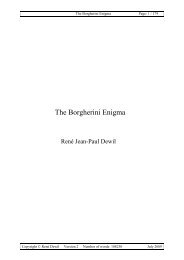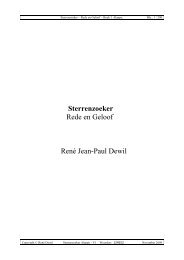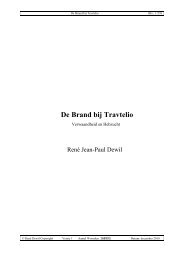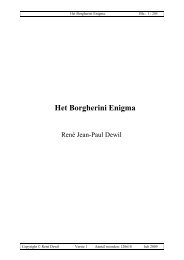A visual Journey into the Bible The Book of Genesis
A visual Journey into the Bible The Book of Genesis
A visual Journey into the Bible The Book of Genesis
You also want an ePaper? Increase the reach of your titles
YUMPU automatically turns print PDFs into web optimized ePapers that Google loves.
A Visual <strong>Journey</strong> <strong>into</strong> <strong>the</strong> <strong>Bible</strong> Page: 32<br />
marvellously to show <strong>the</strong> tragic scene, <strong>the</strong> rapidity, <strong>the</strong> violence and <strong>the</strong> flesh-to-flesh<br />
intimacy <strong>of</strong> murder.<br />
<strong>The</strong> crime takes place in a hidden place, behind rocks and trees, in a corner <strong>of</strong> Eden<br />
that lies in <strong>the</strong> darkness <strong>of</strong> <strong>the</strong> sins <strong>of</strong> humans. All <strong>the</strong> colours in <strong>the</strong> painting are<br />
browns and ochres. On <strong>the</strong> right T<strong>into</strong>retto’s picture opens to a landscape. Here we<br />
see <strong>the</strong> calm waters <strong>of</strong> a lake or a sea. Here Cain wanders on <strong>the</strong> beaches, after <strong>the</strong><br />
crime, hence a small and lonely figure. T<strong>into</strong>retto showed <strong>the</strong> murder but also <strong>the</strong><br />
result <strong>of</strong> murder and sin: <strong>the</strong> remorse and <strong>the</strong> loneliness.<br />
<strong>The</strong> scene is an early <strong>Bible</strong> <strong>the</strong>me, so T<strong>into</strong>retto has not given a knife to Cain, but a<br />
piece <strong>of</strong> spiky wood that can be driven <strong>into</strong> Abel. <strong>The</strong> bro<strong>the</strong>rs might have been<br />
hunting and <strong>the</strong> symbol <strong>of</strong> <strong>the</strong> crime, a decapitated head <strong>of</strong> a deer lies beneath a tree<br />
down on <strong>the</strong> right.<br />
T<strong>into</strong>retto applied a strong composition. Cain is painted along <strong>the</strong> right diagonal.<br />
Abel’s arms are along <strong>the</strong> left diagonal. Cain’s bodyline leads down to <strong>the</strong> deer head,<br />
to <strong>the</strong> crime again, whereas Abel’s bodyline brings <strong>the</strong> eye <strong>of</strong> <strong>the</strong> viewer to <strong>the</strong><br />
innocence <strong>of</strong> <strong>the</strong> blue lake. <strong>The</strong> tree marks about one third <strong>of</strong> <strong>the</strong> picture; Abel’s hand<br />
on <strong>the</strong> ground is on ano<strong>the</strong>r third part <strong>of</strong> <strong>the</strong> frame length. <strong>The</strong> masses <strong>of</strong> <strong>the</strong> two<br />
bodies balance each o<strong>the</strong>r and <strong>the</strong> two bodies toge<strong>the</strong>r balance <strong>the</strong> mass <strong>of</strong> <strong>the</strong> tree.<br />
<strong>The</strong> two bodies <strong>of</strong> Cain and Abel are almost nude. <strong>The</strong>y touch and <strong>the</strong> bodies flow<br />
one around <strong>the</strong> o<strong>the</strong>r in intimate touching. Such a depiction is definitely not<br />
Renaissance anymore. It is all showing <strong>of</strong> violent emotions <strong>of</strong> <strong>the</strong> flesh. T<strong>into</strong>retto’s<br />
lines are all ei<strong>the</strong>r oblique or curving directions. So much exposing <strong>of</strong> twisted, naked<br />
bodies exclaims <strong>the</strong> tension <strong>of</strong> a Mannerist picture. Violence is too tense, too direct<br />
for ei<strong>the</strong>r Renaissance or Baroque depiction. T<strong>into</strong>retto’s ‘Cain and Abel’ is a<br />
painting <strong>of</strong> <strong>the</strong> conflicts <strong>of</strong> <strong>the</strong> Mannerist period. This picture was made somewhat<br />
forty to fifty years before Caravaggio made his first paintings <strong>of</strong> dramatic contrasts <strong>of</strong><br />
light and dark, but all Caravaggio’s main elements <strong>of</strong> style are present in T<strong>into</strong>retto’s<br />
‘Cain and Abel’: strong composition, closeness <strong>of</strong> <strong>the</strong> <strong>the</strong>me to <strong>the</strong> viewer, powerful<br />
depiction <strong>of</strong> bodies in a very realistic way, importance given to <strong>the</strong> main <strong>the</strong>me with<br />
disregard for background decoration, and <strong>of</strong> course a new emphasis on <strong>the</strong> contrasts<br />
between light and dark. But T<strong>into</strong>retto’s painting contains a direct contact <strong>of</strong> flesh that<br />
Caravaggio, even in his own mains scenes <strong>of</strong> violence, avoided and that Caravaggio<br />
always showed with more restraint and distance. T<strong>into</strong>retto was a precursor <strong>of</strong><br />
Caravaggio’s art and it took only some relaxing <strong>of</strong> <strong>the</strong> violence to come to Baroque.<br />
<strong>The</strong> effects <strong>of</strong> light and dark that are so reminiscent <strong>of</strong> <strong>the</strong> Baroque period are already<br />
entirely spectacular in this painting <strong>of</strong> Jacopo T<strong>into</strong>retto. <strong>The</strong> light comes from down<br />
left and rises from Abel’s highlighted back to Cain’s shoulders. T<strong>into</strong>retto’s mastery<br />
<strong>of</strong> light and shadow is total. We cannot but remember Caravaggio’s ‘Sacrifice <strong>of</strong><br />
Isaac’ in which <strong>the</strong> innovative, emphasised dramatic use <strong>of</strong> light and dark is similarly<br />
impressive. <strong>The</strong> colours <strong>of</strong> ‘Cain and Abel’ are very dark. <strong>The</strong> two figures, even<br />
though <strong>the</strong> light is thrown on <strong>the</strong>m, are painted in shades <strong>of</strong> brown and ochre. <strong>The</strong><br />
trees on <strong>the</strong> left and <strong>the</strong> middle are very dark green. With T<strong>into</strong>retto’s pictures it is<br />
<strong>of</strong>ten difficult to ascertain whe<strong>the</strong>r <strong>the</strong>se colours were <strong>the</strong> original ones. T<strong>into</strong>retto’s<br />
green paint became darkened over time to become brown. His blue colours became<br />
grey, his yellows greenish and darker also, his reds paled to pink. We may suppose<br />
Copyright ©: René Dewil Date: October, 24 2000











